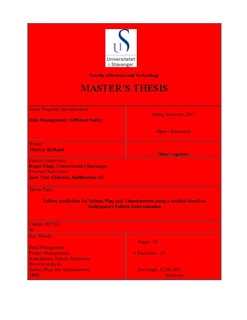Failure prediction for subsea plug and abandonment using a method based on anticipatory failure determination
Master thesis
Permanent lenke
http://hdl.handle.net/11250/302058Utgivelsesdato
2015-06-12Metadata
Vis full innførselSamlinger
- Studentoppgaver (TN-ISØP) [1451]
Sammendrag
The oil and gas industry at the Norwegian Continental Shelf (NCS) is today facing hundreds of subsea wells that will need Plug and Abandonment (PnA) operations in the nearest future. Due to a marked where costs have escalated rapidly over the last half decade, a cost and efficiency strategy for plugging and abandoning these wells had to be made (Statoil 2014).
Halliburton is today in the process of developing an integrated project between different third parties in order to plug and abandon subsea wells in a more efficient and cost friendly manner (Halliburton, Petrobas et al. 2014). Seeing that we are performing the same operation on hundreds of wells, copying Hazard Identification Analysis (HAZID) is an easy way out; but can lead to major incidents and accidents if hazards related to use of new technology, such as subsea PnA, are not identified. In order to prevent this, the first objective for this thesis was to develop a new model for identifying unwanted events. This model is based on events (A) leading to future consequences (C). Moreover, the model is based on Anticipatory Failure Determination (AFD), which is a method where creative solutions to technical problems are created. The fundamental idea with AFD is to ask inverted questions which answer how we are able to create failures. The question “how can we make this operation fail?” is asked throughout this thesis in order to create different events leading to unwanted consequences. In addition, this thesis has developed a four step procedure on how to use the model. The steps involve forward and backward ways of identifying unwanted events. The backwards way are analyzing from consequences to events, while the forwards way are analyzing from events to consequences.
The second objective for this thesis was to use the model we have developed to create failures in subsea PnA. This has been done on parts of the operations that are involved in a subsea PnA, and six new unwanted consequences have been discovered.
The model developed is also applicable for other areas apart from subsea PnA where basic knowledge of the operation, design or scenario already exists. In this thesis, the model is also illustrated for an everyday example, as well as to subsea PnA operations. For further implementation of the model into the oil and gas industry, additional development is required. However, the model is a good start for further development.
Beskrivelse
Master's thesis in Risk management
